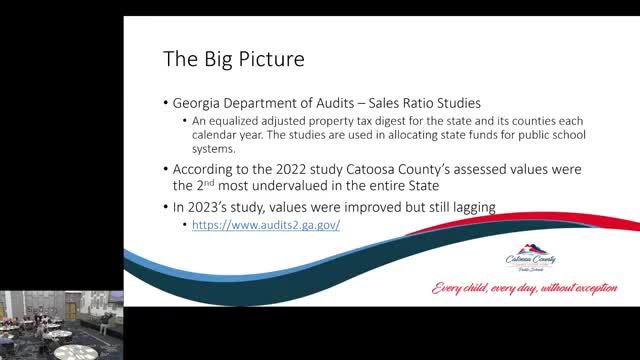Georgia School District faces rising health insurance costs amid funding challenges
March 29, 2025 | Catoosa County, School Districts, Georgia
This article was created by AI summarizing key points discussed. AI makes mistakes, so for full details and context, please refer to the video of the full meeting. Please report any errors so we can fix them. Report an error »

In a recent meeting, officials from the Georgia Department of Audits discussed the results of their annual sales ratio study, which evaluates property values across the state. This year, the study revealed that local property assessments were significantly undervalued, prompting a necessary increase in property values for the upcoming year. In 2022, the assessed values in the area were rated at just 29, far below the ideal score of 40, indicating a pressing need for adjustment to align with actual market values.
The implications of these findings are substantial for the local school district, which relies heavily on property taxes for funding. As property values rise, the state reduces its financial contributions, leaving the district to navigate a complex funding landscape. The district's funding from the state has stagnated, with recent increases in health insurance costs for employees further straining the budget. The monthly cost for health insurance has surged from $945 to nearly $1,885 per employee, leading to an estimated $15 million increase in expenses over four years.
To address these financial challenges, the district is exploring alternative funding sources, including the East Blost sales tax, which has been in place for over 30 years. This tax helps fund capital projects and maintenance without impacting the general fund, allowing the district to maintain facilities and equipment while keeping the tax burden spread across visitors and residents alike.
Additionally, the district is focusing on non-taxpayer generated funds, such as donations and fundraising activities, to support various educational programs and initiatives. These funds are crucial for enhancing student experiences, including field trips and special events, without relying on taxpayer dollars.
As the district prepares for the next school year, officials are also addressing staffing needs, particularly in light of recent retirements and resignations. While the district has made cuts in response to budget constraints, they are committed to filling essential teaching positions to ensure quality education for all students.
In conclusion, the meeting underscored the ongoing financial challenges faced by the school district, driven by rising health insurance costs and fluctuating state funding. As officials work to adapt to these changes, the focus remains on maintaining educational quality and supporting the community through strategic funding initiatives.
The implications of these findings are substantial for the local school district, which relies heavily on property taxes for funding. As property values rise, the state reduces its financial contributions, leaving the district to navigate a complex funding landscape. The district's funding from the state has stagnated, with recent increases in health insurance costs for employees further straining the budget. The monthly cost for health insurance has surged from $945 to nearly $1,885 per employee, leading to an estimated $15 million increase in expenses over four years.
To address these financial challenges, the district is exploring alternative funding sources, including the East Blost sales tax, which has been in place for over 30 years. This tax helps fund capital projects and maintenance without impacting the general fund, allowing the district to maintain facilities and equipment while keeping the tax burden spread across visitors and residents alike.
Additionally, the district is focusing on non-taxpayer generated funds, such as donations and fundraising activities, to support various educational programs and initiatives. These funds are crucial for enhancing student experiences, including field trips and special events, without relying on taxpayer dollars.
As the district prepares for the next school year, officials are also addressing staffing needs, particularly in light of recent retirements and resignations. While the district has made cuts in response to budget constraints, they are committed to filling essential teaching positions to ensure quality education for all students.
In conclusion, the meeting underscored the ongoing financial challenges faced by the school district, driven by rising health insurance costs and fluctuating state funding. As officials work to adapt to these changes, the focus remains on maintaining educational quality and supporting the community through strategic funding initiatives.
View full meeting
This article is based on a recent meeting—watch the full video and explore the complete transcript for deeper insights into the discussion.
View full meeting
